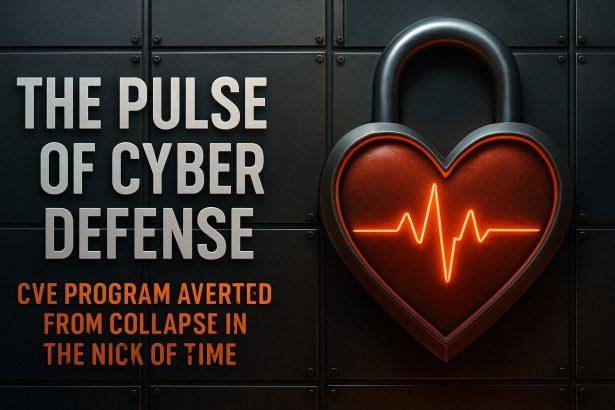In a dramatic eleventh-hour move, the Common Vulnerabilities and Exposures (CVE) program—the centralnervous system of global cybersecurity—was rescued from an imminent shutdown. The U.S. Cybersecurity and Infrastructure Security Agency (CISA) extended MITRE’s management contract mere hours before expiration, staving off a potential crisis that could have paralyzed vulnerability coordination efforts worldwide.
Why CVE Matters: Think of It as the Cyber World’s DNA Test
For cybersecurity professionals, CVEs aren’t just codes—they’re the universal identifiers that define how we detect, catalog, and communicate vulnerabilities. A single CVE ID can mean the difference between swift patching and silent chaos.
Without CVEs, the entire security ecosystem—ranging from enterprise firewalls to your home router—would lack a common language. Researchers, vendors, and security operations teams would be speaking in fragmented dialects, leading to confusion, duplication of effort, and slower responses to threats.
Imagine the COVID-19 pandemic without the term “COVID-19.”
How would governments coordinate lockdowns?
How would vaccine development happen?
How would you even Google symptoms?
That’s the level of systemic disorder we’d face in a world without CVEs. Every vulnerability would be like a mystery illness with no name, diagnosis, or treatment plan.
Funding Crisis Timeline: A Breakdown
Here’s how the drama unfolded over a tense 24-hour window:
| Date | Event |
|---|---|
| April 15, 2025 | MITRE publicly warns that the CVE program’s funding will expire at midnight, potentially causing a shutdown. |
| April 16, 2025, 12:01 AM | CISA executes an emergency contract extension to keep the program alive. |
| April 16, 2025, 11:07 AM | BleepingComputer confirms MITRE’s contract has been extended for 11 more months, narrowly avoiding service interruption. |
Voices from the Edge of the Cliff
As the clock ticked down, security professionals held their breath. The risk wasn’t just bureaucratic—it was existential.
“If a break in service were to occur, we anticipate multiple impacts to CVE, including deterioration of national vulnerability databases, tool vendors, and incident response operations.”
— Yosry Barsoum, Vice President, MITRE
“The CVE Program is invaluable to the cyber community and a priority of CISA.”
— CISA spokesperson, speaking to BleepingComputer
Had the contract lapse not been averted, organizations large and small—from Microsoft and Cisco to mom-and-pop cybersecurity shops—might have lost their real-time lens into threats. SOC teams would’ve been left in the dark. SIEM tools would lose standard input. Incident response would be hamstrung.
The Bigger Picture: A Flawed Dependency?
While the immediate disaster has been narrowly sidestepped, the scare laid bare an uncomfortable truth: the global cybersecurity community is precariously dependent on a single U.S.-funded program.
“It’s like discovering your global internet system depends on a single data center with no backup,”
— Priya Sharma, Security Analyst, via LinkedIn
For years, CVE has been both the gold standard and a single point of failure. While the system works—most of the time—it is fundamentally centralized, U.S.-controlled, and budget-sensitive. This latest funding scare is not the first, and experts warn it won’t be the last unless systemic changes are made.
Global Alternatives Emerging
With mounting concerns about resilience and neutrality, several regions have started building their own vulnerability registries to complement or, in time, compete with CVE.
| Registry | Region | Operator |
|---|---|---|
| CVE | Global (U.S.-based) | MITRE |
| EUVD | Europe | ENISA (European Union Agency for Cybersecurity) |
| JVNDB | Japan | JPCERT/CC |
ENISA’s EUVD is particularly notable as the first significant move by a major bloc to create its own registry. The goal isn’t to displace CVE but to create redundancy, regional autonomy, and a collaborative global ecosystem rather than a monoculture.
What’s Next?
While MITRE’s contract extension provides temporary relief, the structural issues remain. Recognizing this, the CVE Foundation—a nonprofit organization—has launched initiatives to privatize and globalize the program, aiming to decouple its fate from the whims of annual federal budgets.
But even that may not be enough. Some experts argue for an international cybersecurity consortium—similar to how ICANN manages internet names and addresses. Others call for a UN-backed vulnerability authority or open-source-driven governance structure.
One thing is clear: the next crisis is just a fiscal quarter away unless long-term solutions are implemented.
Final Thoughts
The near-collapse of the CVE program is a sobering reminder of how much modern digital life relies on quiet, often overlooked systems. Like the engineers who maintain global undersea cables or the power grid, those behind CVE work largely in the background—until they almost don’t.
This wasn’t just a win for MITRE or CISA. It was a wake-up call to the global cybersecurity community: resilience requires redundancy.




